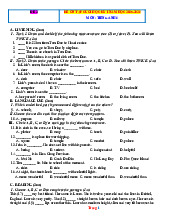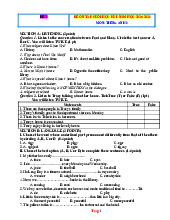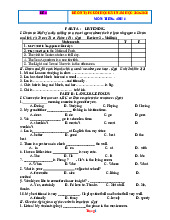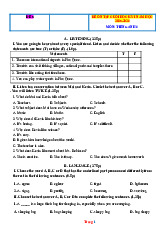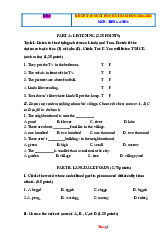













Preview text:
TỔNG HỢP NGỮ PHÁP MÔN TIẾNG ANH LỚP 6
HỌC KÌ 1 NĂM 2020 - 2021
I. The present simple (Thì Hiện Tại Đơn lớp 6)
1. Định nghĩa thì hiện tại đơn: Thì hiện tại đơn (tiếng Anh: Simple present hoặc
Present simple) là một thì diễn tả một hành động chung chung, tổng quát lặp đi lặp lại
nhiều lần hoặc một sự thật hiển nhiên hoặc một hành động diễn ra trong thời gian hiện tại.
2. Cách s ử dụng thì hiện tại đơn
Cách dùng thì hiện tại đơn
- Diễn đạt một thói quen hoặc hành động lặp đi lặp lại trong hiện tại
- Chân lý, sự thật hiển nhiên
- Sự việc xảy ra trong tương lai. Cách này thường áp dụng để nói về thời gian biểu,
chương trình hoặc kế hoạch đã được cố định theo thời gian biểu.
- Sử dụng trong câu điều kiện loại 1.
- Sử dụng trong một số cấu trúc khác
3. Công thức thì hi ện tại đơn Thể
Động từ “tobe”
Động từ “thường” Khẳng S + am/are/is S + V(e/es) định S + am/are/is + not +
S + do/ does + not + V(ng.th ể)
Phủ định Note : is not = isn’t ;
Note : do not = don’t
are not = aren’t
does not = doesn’t Yes – No question Yes – No question
Do/ Does (not) + S + V(ng.thể)..? Am/ Are/ Is (not) + S + ….? Yes, S + do/ does. Yes, S+ am/ is/ are Nghi vấn No, S + don’t/ doesn’t. No, S+ am/is/are +not. Wh- questions Wh- questions
Wh + do/ does(not) + S + V(nguyên
Wh + am/ are/ is (not) + S + …? thể)….? Cách thêm s/es:
– Thêm s vào đằng sau hầu hết các động từ: want-wants; work-works;…
– Thêm es vào các động từ kết thúc bằng ch, sh, x, s: watch-watches;
miss-misses; wash-washes; fix-fixes;…
– Bỏ y và thêm ies vào sau các động từ kết thúc bởi một phụ âm + y:study-studies;…
– Động từ bất quy tắc: Go-goes; do-does; have-has. Lưu ý
Cách phát âm ph ụ âm cuối s/es: Chú ý các phát âm ph ụ âm
cuối này phải dựa vào phiên âm qu ốc tế chứ không dựa vào cách vi ết.
– /s/:Khi từ có tận cùng là các phụ âm /f/, /t/, /k/, /p/ , /ð/
– /iz/:Khi từ có tận cùng là các âm /s/, /z/, /∫/, /t∫/, /ʒ/, /dʒ/ (thường có tận
cùng là các chữ cái ce, x, z, sh, ch, s, ge)
– /z/:Khi từ có tận cùng là nguyên âm, các phụ âm còn lại
4. Dấu hiệu nhận biết thì hi ện tại đơn
+ Always (luôn luôn) , usually (thường xuyên), often (thường xuyên), frequently (thường
xuyên) , sometimes (thỉnh thoảng), seldom (hiếm khi), rarely (hiếm khi), hardly (hiếm
khi) , never (không bao giờ), generally (nhìn chung), regularly (thường xuyên).
+ Every day, every week, every month, every year,……. (Mỗi ngày, mỗi tuần, mỗi tháng, mỗi năm)
+ Once/ twice/ three times/ four times….. a day/ week/ month/ year,……. (một lần / hai
lần/ ba lần/ bốn lần ……..một ngày/ tuần/ tháng/ năm)
II. The present continuous (Thì hiện tại tiếp diễn lớp 6) 1. Công thức :
Khẳng định: S +am/ is/ are + V_ing + O
Phủ định: S + am/ is/ are+ not + V_ing + O
Nghi vấn:Am/is/are+S + V_ing+ O ?
2. Dấu hiệu nhận biết thì hi ện tại tiếp diễn:
Thì hiện tại tiếp diễn trong câu thường có những cụm từ sau: At present, at the moment,
now, right now, at, look, listen.… 3.Cách dùng:
+ Diễn tả hành động đang diễn ra và kéo dài trong hiện tại.
EX: She is going to school at the moment.
+ Dùng để đề nghị, cảnh báo, mệnh lệnh.
Ex: Be quiet! The baby is sleeping in the bedroom.
+ Dùng để diễn tả một hành động sắp xảy ra trong tương lai theo kế hoạch đã định trước
Ex: I am flying to Moscow tomorrow.
+ Diễn tả sự không hài lòng hoặc phàn nàn về việc gì đó khi trong câu có “always”.
Ex: She is always coming late.
Note : Không dùng thì hiện tại tiếp diễn với các động từ chỉ tri giác, nhận thức như : to
be, see, hear,feel, realize, seem, remember, forget, understand, know, like , want , glance, think, smell, love, hate…
Ex: He wants to go for a cinema at the moment.
III. Cấu trúc There is và There are Thể khẳng định
Với thể khẳng định, có 3 nguyên tắc sử dụng cấu trúc There + be +…
a, Nguyên tắc 1: There is + singular noun (danh từ số ít)
Ví dụ: – There is a pen in my lovely pencil case. – There is an apple in the picnic basket.
b, Nguyên tắc 2: There are + plural noun (danh từ số nhiều)
– There are pens in my lovely pencil case.
– There are three apples in the picnic basket.
– There are many trees in my grandparents’ garden. c, Nguyên tắc 3:
There is + uncountable noun (danh từ không đếm được)
– There is hot water in the bottle.
– There is some rice left on the plate.
Thể phủ định: Ở thể phủ định, sau động từ to be sẽ có thêm từ not và thường có
thêm từ any để nhấn mạnh sự không tồn tại của một thứ gì đó. Tương tự, cũng có 3 nguyên tắc:
a, Nguyên t ắc 1: There is not + singular noun
– There is not any book on the shelf.
b. Nguyên t ắc 2: There are not + plural noun
– There are not any students in the classroom right now.
c.Nguyên tắc 3: There is not + uncountable noun
– There is not any milk in the fridge. III. Thể nghi v ấn
a. Câu hỏi Yes/ No: Đối với câu hỏi Yes/No, chúng ta đặt động từ to be ra trước
từ there để tạo thành câu hỏi. Từ any được dùng với câu hỏi cho danh từ số nhiều và
danh từ không đếm được.
Is there a ball in the present box? Yes, there is.
Is there an eraser in your school bag? No, there is not.
Are there any students taking part in the event? Yes, there are.
Are there any pets in your family? No, there are not.
b. Câu hỏi How many…?
How many + plural noun ( danh từ số nhiều) + are there +…?
How many brothers and sisters are there in your house?
How many oranges are there in your lunchbox?
How many fish are there in the fish tank? Thể rút gọn
There is = There’s
There is not = There’s not = There isn’t
There are = There’re
There are not = There’re not = There aren’t
IV. Prepositions of place (Gi ới từ chỉ địa điểm) Preposition Explanation Example of place
· I watch TV in the living-room · I live in New York
· Look at the picture in the book In Inside
· She looks at herself in the mirror.
· I met her at the entrance, at the bus stop
· She sat at the table used to show an exact At position or particular place
· at a concert, at the party
· at the movies, at university, at work
+ next to or along the side of · Look at the picture on the wall (river)
· Cambridge is on the River Cam. + used to show that
· The book is on the desk something is in a position above something else and · A smile on his face touching it.
· The shop is on the left + left, right
· My apartment is on the first floor On + a floor in a house
· I love traveling on trains /on the bus / + used for showing some on a plane methods of traveling
· My favorite program on TV, on the + television, radio radio by, next to,
· The girl who is by / next to / beside beside, near the house. + not far away in distance
+ in or into the space which · The town lies halfway between Rome between
separates two places, people and Florence. or objects behind + at the back (of)
· I hung my coat behind the door. + further forward than
· She started talking to the man in front in front of someone or something else of her + lower than (or covered by) Under
· the cat is under the chair. something else Below
+ lower than something else. · the plane is just below the the cloud + above or higher than
something else, sometimes so · She held the umbrella over both of us. that one thing covers the other.
· Most of the carpets are over $100. Over
+ across from one side to the · I walked over the bridge other.
· She jumped over the gate + overcoming an obstacle + higher than something else, Above
· a path above the lake but not directly over it + from one side to the other
· She walked across the field/road. of something with clear Across limits / getting to the other
· He sailed across the Atlantic side + from one end or side of
· They walked slowly through the Through something to the other woods. + in the direction of
· We went to Prague last year. To + bed · I go to bed at ten. Into + towards the inside or
· Shall we go into the garden? middle of something and about to be contained, surrounded or enclosed by it
+ in the direction of, or closer · She stood up and walked towards Towards to someone or something him. + used to show movement
· I slipped as I stepped onto the Onto into or on a particular place platform. + used to show the place
· What time does the flight from From where smb or sth starts Amsterdam arrive?
V. Verb “ be/ have” for description (Sử dụng to be và have để miêu tả)
1. Sử dụng to be để miêu tả : Chúng ta thường sử dụng động từ to be để miêu tả ngoại hình hoặc tính cách.
Dạng khẳng định : S + to be + adj.
Eg: I am confident. (I'm confident.) (Tôi tự tin.)
They are clever. (They're clever.) (Họ thông minh.)
She is beautiful. (She's beautiful.) (Cô ấy xinh đẹp.)
2 . Sử dụng have để miêu tả: Chúng ta thường dùng have để miêu tả ngoại hình.
Dạng khẳng định : S + have/ has + (a/ an) + adj. + body part
Eg: I have long hair. (Tôi có mái tóc dài.)
The cat has green eyes. (Con mèo có đôi mắt màu xanh lá cây.)
VI. The Present Continuous to talk about the future (Thì hiện tại tiếp diễn để nói về
các dự định trong tương lai)
The present continuous is used to talk about arrangements for events at a time later than now.
There is a suggestion that more than one person is aware of the event, and that some
preparation has already happened. E.g.
1. I'm meeting Jim at the airport = Jim and I have discussed this.
2. I am leaving tomorrow. = I've already bought my train ticket.
3. We're having a staff meeting next Monday = all members of staff have been told about it. Eg:
1. Is she seeing him tomorrow?
2. He isn't working next week.
3. They aren't leaving until the end of next year.
4. We are staying with friends when we get to Boston.
Note: In the first example, "seeing" is used in a continuous form because it means "meeting".
BE CAREFUL! The simple present is used when a future event is part of a program or time-table.
Notice the difference between:
a. We're having a staff meeting next Monday = just that once
b. We have a staff meeting every Monday
VII. Comparative (So sánh hơn)
a. Tính từ ngắn: Tính từ có 1 âm tiết, hoặc 2 âm tiết nhưng chữ cái cuối cùng của âm
tiết thứ hai có kết thúc là –y, –le,–ow, –er, và –et được cho là tính từ ngắn.
Eg: Short – /ʃɔːrt/: ngắn Sweet – /swiːt/: ngọt Clever –khéo léo, khôn khéo
b. Tính t ừ dài: Những tính từ có từ ba âm tiết trở lên được gọi là tính từ dài.
Ví dụ: Beautiful /: đẹp Intelligent –thông minh Expensive –/: đắt đỏ c. Công thức
Short Adj:S + V + adj + er + than + N/pronoun
Long Adj: S + V + more + adj + than + N/pronoun Eg: She is taller than I/me
This book is more intelligent than that one.
Dạng khác: S + V + less + adj + than + N/pronoun.(ít hơn) Note :
+ Trong câu so sánh hơn kém, đối với tính từ ngắn ta chỉ cần thêm – er vào sau. Trong
câu so sánh hơn nhất thêm – est.
Eg: Sharp – sharper – the sharpest: sắc – sắc hơn – sắc nhất
Light – lighter – the lightest: nhẹ – nhẹ hơn – nhẹ nhất
+ Thêm –r nếu tính từ kết thúc tận cùng bằng nguyên âm – e trong câu so sánh hơn kém,
hoặc thêm –st nếu trong câu so sánh cao nhất.
Eg : Nice – nicer – the nicest: đẹp – đẹp hơn – đẹp nhất
Close – closer – the closest: gần – gần hơn – gần nhất
+ Nếu tính từ kết thúc bằng “y” thì trong câu so sánh ta bỏ “y” để thêm -ier trong câu so
sánh hơn kém, và thêm -iest trong câu so sánh cao nhất.
Eg: Happy – happier – the happiest: hạnh phúc – hạnh phúc hơn – hạnh phúc nhất
Easy – easier – the easiest: dễ dàng – dễ dàng hơn – dễ dàng nhất
+ Nếu trước phụ âm sau cùng là một nguyên âm thì cần gấp đôi phụ âm đó rồi mới thêm – er hoặc – iest.
Eg: Hot – hotter – the hottest: nóng – nóng hơn – nóng nhất
Big – bigger – the biggest: to lớn – to hơn – to nhất
+ Trong câu so sánh hơn kém chỉ cần thêm more vào trước tính từ, trong câu so sánh hơn
nhất thì thêm the most vào trước tính từ.
Eg : More beautiful – the most beautiful: đẹp hơn – đẹp nhất
+ Những tính từ ngắn kết thúc bằng –ed vẫn dùng more hoặc most trước tính từ trong câu so sánh.
Eg : Pleased – more pleased – the most pleased: hài lòng – hài lòng hơn – hài lòng nhất
Tired – more tired – the most tired: mệt mỏi
+ Những tính từ kết thúc bằng –le,–ow, –er, và –et thì có thể vừa thêm -er, -iest vào sau
hoặc thêm more, the most vào trước tính từ.
Eg : Quiet – quieter – quietest /more quiet – the most quiet: yên lặng – yên lặng hơn – yên lặng nhất
Clever – cleverer/ – cleverest/ more clever – the most cleaver: khéo léo – khéo léo hơn – khéo léo nhất
Narrow – narrower – narrowest /more narrow – the most narrow: hẹp – hẹp hơn – hẹp nhất
Simple – simpler – simplest /more simple – the most simple: đơn giản – đơn giản hơn – đơn giản nhất
+ Một số tính từ bất quy tắc khi so sánh hơn kém và cao nhất, phải học thuộc chúng.
Eg : Good – better – best: tốt – tốt hơn – tốt nhất
Well (healthy) – better: khỏe – khỏe hơn
Bad – worse – worst: tệ – tệ hơn – tệ nhất
Far – farther/further – the farthest/furthest: xa – xa hơn – xa nhất
VIII. Superlative (So sánh nhất)
Short adj:S + V + the + adj + est + N/pronoun
Long adj:S + V + the most + adj + N/pronoun.
Ex: She is the tallest girl in the village.
He is the most gellant boy in class.
Dạng khác:S + V + the least + adj + N/pronoun(ít nhất)
Các tính từ so sánh đặc biệt
good/better/the best bad/worse/the worst many(much)/more/the most
little/less/the least far/farther(further)/the farthest(the furthest)
IX. Cấu trúc với Must (Phải, cần phải) Thể khẳng định:
S + must + verb (inf. without to) Thể phủ định:
S + must not/ mustn’t + Vinf. [viết tắt: must not = mustn’t] Thể nghi vấn: Must + S + verb…?
+ Must được dùng để đưa ra một lời khuyên, hoặc một đề nghị được nhấn mạnh.
Eg: He mustn’t see that film. It’s for adults only.
You must take more exercise. Join a tennis club.
X. Cách dùng & cấu trúc với Should (nên) Use Example
Diễn tả một lời khuyên, một việc You should study hard for the tốt nên thực hiện. final exam.
Dùng để hỏi, xin ý kiến, nêu ý kiến We think he should give up
về một vấn đề gì đó. smoking.
Diễn tả một điều gì đó không đúng, They gave up, but they should
hoặc không như mong đợi.
continue soluting the difficult.
Should (not)+ Diễn tả một suy đoán, hoặc kết luận She prepared for the competition V
một điều gì đó có thể xảy ra trong very well, so she should she tương lai. should win.
Cách dùng tương tự như should và You are so green. You had better
ought to, nhưng nhấn mạnh sự cần go to hospital. Had better
thiết, và mong muốn hành động hơn
XI. Simple future tense (Thì tương lai đơn)
a. Định nghĩa thì tương lai đơn Thì tương lai đơn trong tiếng anh (Simple future
tense) được dùng khi không có kế hoạch hay quyết định làm gì nào trước khi chúng ta
nói. Chúng ta ra quyết định tự phát tại thời điểm nói. Thường sử dụng thì tương lai đơn
với động từ to think trước nó.
b. Cách dùng thì tương lai đơn
- Diễn đạt một quyết định tại thời điểm nói
- Đưa ra lời yêu cầu, đề nghị, lời mời
- Diễn đạt dự đoán không có căn cứ
c. Công thức thì tương lai đơn Câu khẳng định Câu phủ định Câu nghi v ấn Will + S + V(nguyên thể) S + will + V(nguyên thể)
S + will not + V(nguyên thể) Trả lời: Yes, S + will./ No, S + won’t.
d. Dấu hiệu nhận biết thì tương lai đơn
Trong câu có các trạng từ chỉ thời gian trong tương lai:
– in + thời gian: trong … nữa (in 2 minutes: trong 2 phút nữa) – tomorrow: ngày mai
– Next day: ngày hôm tới
– Next week/ next month/ next year: Tuần tới/ tháng tới/ năm tới
Trong câu có những động từ chỉ quan điểm như:
– think/ believe/ suppose/ …: nghĩ/ tin/ cho là
